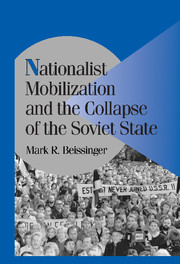Book contents
- Frontmatter
- Contents
- Illustrations
- Tables
- Acknowledgments
- 1 FROM THE IMPOSSIBLE TO THE INEVITABLE
- 2 THE TIDE OF NATIONALISM AND THE MOBILIZATIONAL CYCLE
- 3 STRUCTURING NATIONALISM
- 4 “THICKENED” HISTORY AND THE MOBILIZATION OF IDENTITY
- 5 TIDES AND THE FAILURE OF NATIONALIST MOBILIZATION
- 6 VIOLENCE AND TIDES OF NATIONALISM
- 7 THE TRANSCENDENCE OF REGIMES OF REPRESSION
- 8 RUSSIAN MOBILIZATION AND THE ACCUMULATING “INEVITABILITY” OF SOVIET COLLAPSE
- 9 CONCLUSION: NATIONHOOD AND EVENT
- Appendix I PROCEDURES FOR APPLYING EVENT ANALYSIS TO THE STUDY OF SOVIET PROTEST IN THE GLASNOST' ERA
- Appendix II SOURCES FOR THE COMPILATION OF EVENT DATA IN A REVOLUTIONARY CONTEXT
- Index
- Titles in the series
1 - FROM THE IMPOSSIBLE TO THE INEVITABLE
Published online by Cambridge University Press: 18 November 2009
- Frontmatter
- Contents
- Illustrations
- Tables
- Acknowledgments
- 1 FROM THE IMPOSSIBLE TO THE INEVITABLE
- 2 THE TIDE OF NATIONALISM AND THE MOBILIZATIONAL CYCLE
- 3 STRUCTURING NATIONALISM
- 4 “THICKENED” HISTORY AND THE MOBILIZATION OF IDENTITY
- 5 TIDES AND THE FAILURE OF NATIONALIST MOBILIZATION
- 6 VIOLENCE AND TIDES OF NATIONALISM
- 7 THE TRANSCENDENCE OF REGIMES OF REPRESSION
- 8 RUSSIAN MOBILIZATION AND THE ACCUMULATING “INEVITABILITY” OF SOVIET COLLAPSE
- 9 CONCLUSION: NATIONHOOD AND EVENT
- Appendix I PROCEDURES FOR APPLYING EVENT ANALYSIS TO THE STUDY OF SOVIET PROTEST IN THE GLASNOST' ERA
- Appendix II SOURCES FOR THE COMPILATION OF EVENT DATA IN A REVOLUTIONARY CONTEXT
- Index
- Titles in the series
Summary
… we travel abroad to discover in distant lands something whose presence at home has become unrecognizable.
Michel de Certeau, The Practice of Everyday LifeOn May 18, 1991, two Soviet cosmonauts blasted off from the Baikonur cosmodrome for a routine four-month mission aboard the Mir space station. While aloft in weightlessness, below them one world died and another was born. By the time they returned to Earth, they no longer knew whether the country that had dispatched them still existed and to which state they and their spacecraft belonged.
The shattering of the Soviet state was one of the pivotal transformations of the twentieth century. It fundamentally altered the world in which we live, provoking an end to half a century of communist domination in Eastern Europe, breaching the Cold War division of the planet, and prompting new disorders with which the twenty-first century will long grapple. But the breakup of the USSR also presents us with many paradoxes that challenge our understanding of politics. The Soviet Union was a nuclear superpower with global commitments and a seventy-four-year record of survival – a polity which had endured two devastating wars, several famines involving millions of deaths, the mass annihilation of its own citizens by its rulers, and a social revolution that brought it into the industrial world. It was a state which launched the first human into space, whose founding political ideas inspired millions throughout the world, and which was widely regarded by many social scientists as a model of successful transition to modernity.
- Type
- Chapter
- Information
- Publisher: Cambridge University PressPrint publication year: 2002



